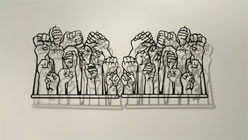Stickers and graffiti cover the walls, the ceiling, and the floors as you ascend the interior stairwell of the Luggage Store Gallery. Over the years, many artists, and indeed many visitors, have made their mark here. Taraneh Hemami’s Fist (all works 2013), a powder coated aluminum and Plexiglas sculpture of a clenched fist raised in solidarity, is positioned at the top of the stairs, increasingly visible with each step. It presents a striking emblem of the Luggage Store’s long legacy as a fundamentally gritty alternative nonprofit arts space and embodies the same spirit of the layered stickers in the long entrance. It also offers visual entre to Hemami’s solo exhibition of largely sculptural new works that explore the visual history of resistance leading up to and beyond the 1979 Iranian Revolution.
The work is a mix of industrial fabrications and hand wrought objects. One corner of the gallery presents Notes from Evin Prison, a series of seven wall-mounted, powder-coated aluminum graphic sculptures. In one work, a cluster of upraised fists increases in number with its shadows. Evin Prison, located in northwestern Tehran, is renowned for its detention of political prisoners before, during and after the revolution; it has often been referred to as “Evin University” because it housed so many intellectuals.

Taraneh Hemami, Notes from Evin Prison series detail, 2013; Courtesy of Luggage Store Gallery.

Taraneh Hemami, Theory of Survival, book covers, 2012-2013; Courtesy of Luggage Store Gallery.
Further along the same wall is Theory of Survival, book covers a grid of nine wood panels that depict key revolutionary figures. Following the fall of the Shah, these activists were martyred for their efforts. Hemami has assembled these portraits from glass frit, small shards of crushed glass that exemplify for her “the shattered ideologies” of the some 4,000 people who were imprisoned and later executed after dedicating their lives to the movement. Luggage Store Gallery co-director Laurie Lazer noted the challenge of installing the work: the next day her palms were covered with dozens of tiny cuts, too small to see and yet irritating. Hemami notes that she often bleeds while assembling the work and concedes that her visceral experience of pain is essential to recognizing the dedication of the activists who gave everything in an era of palpable and diverse convictions. For Hemami, who was born and raised in Tehran, the work is a path towards understanding her own obscured history and a way to place these stories in the broad history of activism.




